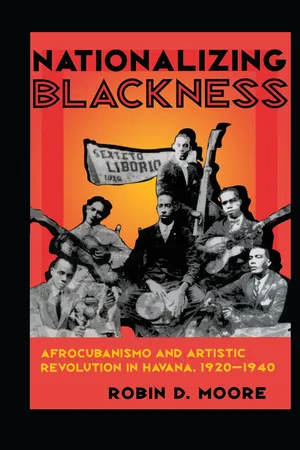
Pitt Latin American Series
Afrocubanismo and Artistic Revolution in Havana, 1920–1940
- English
- PDF
- Available on iOS & Android
Pitt Latin American Series
Afrocubanismo and Artistic Revolution in Havana, 1920–1940
About This Book
The 1920s saw the birth of the tango, the "jazz craze, " bohemian Paris, the Harlem Renaissance, and the primitivists. It was a time of fundamental change in the music of nearly all Western countries, including Cuba. Significant concessions to blue-collar and non-Western aesthetics began on a massive scale, making artistic expression more democratic.In Cuba, from about 1927 through the late thirties, an Afrocubanophile frenzy seized the public. Strong nationalist sentiments arose at this time, and the country embraced afrocubanismo as a means of expressing such feelings. Black street culture became associated with cubanidad (Cubanness) and a movement to merge once distinct systems of language, religion, and artistic expression into a collective of national identity. Nationalizing Blackness uses the music of the 1920s and 1930s to examine Cuban society as it begins to embrace Afrocuban culture. Moore examines the public debate over "degenerate Africanisms" associated with comparas or carnival bands; similar controversies associated with son music; the history of blackface theater shows; the rise of afrocubanismo in the context of anti-imperialist nationalism and revolution against Gerardo Machado; the history of cabaret rumba; an overview of poetry, painting, and music inspired by Afrocuban street culture; and reactions of the black Cuban middle classes to afrocubanismo. He has collected numerous illustrations of early twentieth-century performers in Havana, many included in this book. Nationalizing Blackness represents one of the first politicized studies of twentieth-century culture in Cuba. It demonstrates how music can function as the center of racial and cultural conflict during the formation of a national identity.
Frequently asked questions
Information
Table of contents
- Contents
- Preface
- Introduction
- 1. Afrocubans and National Culture
- 2. Minstrelsy in Havana: Music and Dance of the Teatro Vernáculo
- 3. Comparsas and Carnival in the New Republic: Four Decades of Cultural Controversy
- 4. Echale Salsita: Sones and Musical Revolution
- 5. Nationalizing Blackness: The Vogue of Afrocubanismo
- 6. The Rumba Craze: Afrocuban Arts as International Popular Culture
- 7. The Minorista Vanguard: Modernism and Afrocubanismo
- Conclusion
- Appendices
- Notes
- Glossary
- References
- Index